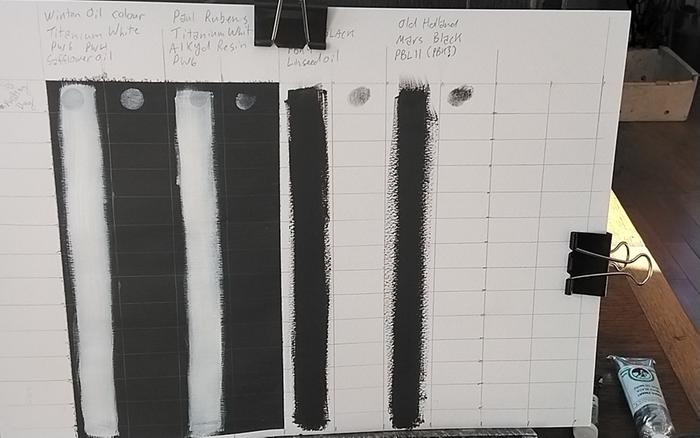From left to right:
Winton - Titanium white
Paul Rubens - Titanium white in Alkyd resin (fast drying version of their oil paints)
Winton - Ivory Black
Old Holland - Mars Black
My theory, the Winton paints will dry considerably faster than the supposed fast drying paints. But it would be nice if I was wrong as almost nowhere has winton white or black in stock right now.

Observations on day one.
I'm getting used to winton and this went on with very little elbow grease. The white was a bit transparent, but a touch more paint did the trick for the most part (although I suspect it might become more transparent as it dries as it sometimes does that).
Paul Rubens took about four or five times as much paint as winton white to get an opaque layer. The paint was quite greasy and less pasty. It also didn't have a fun texture to paint with, kind of sticky.
Paul Rubens is a fairly new brand of paint (the other two have been making paint for over 100 years - old holland started in 1667). I feel like Paul Rubens is still finding it's footing when it comes to paint making as they seem to adjust their formula every few years. For this tube of paint, it felt very much like there was insufficient pigment to oil ratio.
Old Holland is THICK paint. It took very little to become opaque, but the paint was so thick right from the tube it was hard to spread around. It took about 1/10th the amount of paint than winton and I think it could have used less if I had the ability to spread it more.
Old Holland is one of the top, if not The Top fine arts oil paint maker in the world. Their style is to pack it full of pigment to make as stiff a paint as possible. That way we get as much pigment for our buck as we can and it's assumed that one will be using medium with this paint. Medium would change the drying time significantly. So I didn't go this path and instead stuck with right from the tube. But I left a space for it just in case I want to try it later.

